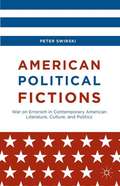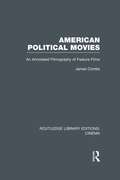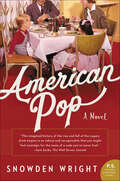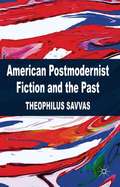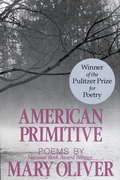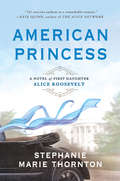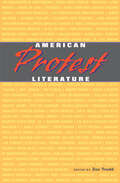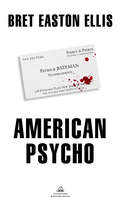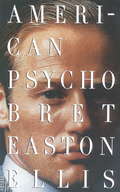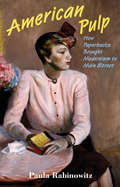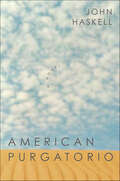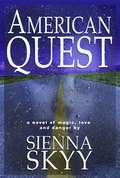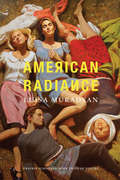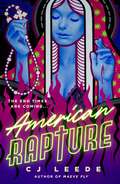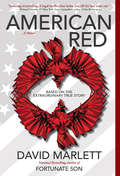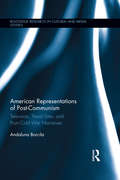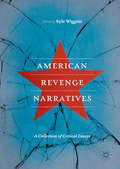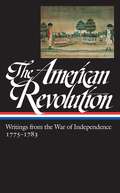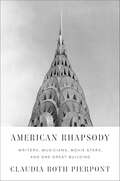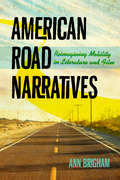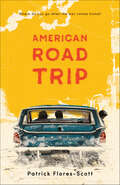- Table View
- List View
American Political Fictions
by Peter SwirskiAmerican Political Fictions rewrites the book on American political art in a myth-busting study that ranges from historical 'faction' and apocalyptic thrillers to satirical fiction, rap poetry, TV'sThe West Wing, and not least the make-believe that streams out of the White House. It critically, not to say skeptically, sieves out historical facts from a sea of partisan and bipartisan disinformation in order to forge a more accurate picture of contemporary American culture and, through it, of America itself. In the process, it elucidates the ideological underpinnings, cultural manifestations, and democratic essence of contemporary political art - and of the partisan politics on which it feeds.
American Political Movies: An Annotated Filmography of Feature Films (Routledge Library Editions: Cinema)
by James CombsEssays here explore the relationship between politics and explicitly political feature films from the beginning of the movie industry to World War I, and for each decade through to the 1980's. The included filmography is particularly useful. Originally published in 1990, the method of inquiry put forward in this text is nonetheless extendable to the decades following its publication.
American Pop: A Novel
by Snowden WrightAN NPR BEST BOOK OF THE YEAR“Mr. Wright’s imagined history of the rise and fall of the sugary drink empire is so robust and recognizable that you might feel nostalgic for the taste of a soda you’ve never had.” – Sam Sacks, TheWall Street JournalNAMED A MOST ANTICIPATED BOOK BY Parade • Cosmopolitan • Town & Country•AARP • InStyle • Garden & Gun • Vol. 1 BrooklynThe story of a family.The story of an empire. The story of a nation.Moving from Mississippi to Paris to New York and back again, a saga of family, ambition, passion, and tragedy that brings to life one unforgettable Southern dynasty—the Forsters, founders of the world’s first major soft-drink company—against the backdrop of more than a century of American cultural history. The child of immigrants, Houghton Forster has always wanted more—from his time as a young boy in Mississippi, working twelve-hour days at his father’s drugstore; to the moment he first laid eyes on his future wife, Annabelle Teague, a true Southern belle of aristocratic lineage; to his invention of the delicious fizzy drink that would transform him from tiller boy into the founder of an empire, the Panola Cola Company, and entice a youthful, enterprising nation entering a hopeful new age.Now the heads of a preeminent American family spoken about in the same breath as the Hearsts and the Rockefellers, Houghton and Annabelle raise their four children with the expectation they’ll one day become world leaders. The burden of greatness falls early on eldest son Montgomery, a handsome and successful politician who has never recovered from the horrors and heartbreak of the Great War. His younger siblings Ramsey and Lance, known as the “infernal twins,” are rivals not only in wit and beauty, but in their utter carelessness with the lives and hearts of others. Their brother Harold, as gentle and caring as the twins can be cruel, is slowed by a mental disability—and later generations seem equally plagued by misfortune, forcing Houghton to seriously consider who should control the company after he’s gone.An irresistible tour de force of original storytelling, American Pop blends fact and fiction, the mundane and the mythical, and utilizes techniques of historical reportage to capture how, in Nathaniel Hawthorne’s words, “families are always rising and falling in America,” and to explore the many ways in which nostalgia can manipulate cultural memory—and the stories we choose to tell about ourselves.
American Postmodernist Fiction and the Past
by Theophilus SavvasThrough a close-reading of the work of five prominent American postmodernist writers, this book re-evaluates the role of the past in recent American fiction, outlines the development of the postmodernist historical novel and considers the waning influence of postmodernism in contemporary American literature.
American Primitive
by Mary OliverA collection of poems by Mary Oliver, an American poet that won the Pulitzer Prize for Poetry in 1984.
American Princess: A Novel of First Daughter Alice Roosevelt
by Stephanie Marie Thornton“As juicy and enlightening as a page in Meghan Markle's diary.”—InStyle“Presidential darling, America’s sweetheart, national rebel: Teddy Roosevelt’s swashbuckling daughter Alice springs to life in this raucous anthem to a remarkable woman.”—Kate Quinn, New York Times bestselling author of The Alice NetworkA sweeping novel from renowned author Stephanie Marie Thornton...Alice may be the president's daughter, but she's nobody's darling. As bold as her signature color Alice Blue, the gum-chewing, cigarette-smoking, poker-playing First Daughter discovers that the only way for a woman to stand out in Washington is to make waves--oceans of them. With the canny sophistication of the savviest politician on the Hill, Alice uses her celebrity to her advantage, testing the limits of her power and the seductive thrill of political entanglements.But Washington, DC is rife with heartaches and betrayals, and when Alice falls hard for a smooth-talking congressman it will take everything this rebel has to emerge triumphant and claim her place as an American icon. As Alice soldiers through the devastation of two world wars and brazens out a cutting feud with her famous Roosevelt cousins, it's no wonder everyone in the capital refers to her as the Other Washington Monument--and Alice intends to outlast them all.
American Protest Literature (The John Harvard library #99)
by Howard Zinn“I like a little rebellion now and then”—so wrote Thomas Jefferson to Abigail Adams, enlisting in a tradition that throughout American history has led writers to rage and reason, prophesy and provoke. This is the first anthology to collect and examine an American literature that holds the nation to its highest ideals, castigating it when it falls short and pointing the way to a better collective future.American Protest Literature presents sources from eleven protest movements—political, social, and cultural—from the Revolution to abolition to gay rights to antiwar protest. Each section reprints documents from the original phase of the movement as well as evidence of its legacy in later times. Informative headnotes place the selections in historical context and draw connections with other writings within the anthology and beyond. Sources include a wide variety of genres—pamphlets, letters, speeches, sermons, legal documents, poems, short stories, photographs, posters—and a range of voices from prophetic to outraged to sorrowful, from U.S. Presidents to the disenfranchised. Together they provide an enlightening and inspiring survey of this most American form of literature.
American Psycho (Tiempos Modernos Ser. #3)
by Bret Easton EllisLa novela más infame de Bret Easton Ellis: un clásico contemporáneo que se ha convertido en símbolo de una generación. «La vida era como un lienzo en blanco, un cliché, un culebrón. Me sentía letal, al borde de la histeria. Mis ansias nocturnas de sangre inundaban también mis días y tuve que dejar la ciudad. Mi máscara de cordura amenazaba con desaparecer. Para mí era la estación más dura y necesitaba vacaciones.» El sofisticado, inteligente y vanidoso Patrick Bateman trabaja en Wall Street, idolatra al joven magnate Donald Trump, cena en los restaurantes de moda de Nueva York y es capaz de distinguir un traje Armani a cincuenta metros de distancia. También le gusta violar, torturar, asesinar y desmembrar. American Psycho, la novela más polémica de Bret Easton Ellis, se ha convertido en el reflejo más descarnado de la sociedad hipermaterialista de finales de los 80 y en una de las obras maestras de finales del siglo XX. Bret Easton Ellis lanza una crítica corrosiva hacia el egoísmo y la depravación del capitalismo exacerbado: un retrato desolador, irónico y rabiosamente vigente de un mundo al borde del colapso en el que todavía vivimos. Críticas:«American Psycho sigue siendo la exégesis literaria más indispensable y salvaje sobre la sociedad que hemos construido.»Irvine Welsh «American Psycho era y es y será una obra maestra de la literatura estadounidense del siglo XX [...] símbolo y metáfora y síntoma y paradigma [...] Con prosa y dicción que se las arregla para fundir lo mejor Ernest Hemingway y Joan Didion y HAL 9000.»Rodrigo Fresán «Un libro fundamental.»Fay Weldon, The Washington Post «Esto es seguro: esta novela se adelantó a su tiempo.»Dwight Garner, The New York Times «Seria, inteligente y rompedoramente efectiva [...] Es un retrato tremendamente coherente de una sociedad mortalmente adicta al aburrimiento, debería ser juzgada dentro de los más altos estándares.»Sunday Times «American Psycho es hilarante. Además de una pesadilla repulsiva, Patrick Bateman es una creación cómica de primer orden.»Sam Jordison, The Guardian «Hoy en día, American Psycho es una obra canónica de sátira social [...] la única y más condenatoria crítica de las consecuencias culturales del capitalismo contemporáneo»John Pa Rollert, Chicago Booth Review «Que los contenidos del libro son escandalosos es completamente indiscutible, pero de la misma manera que La hoguera de las vanidades expuso la corrupción y la avaricia resultantes de las políticas de los años ochenta y sus altos niveles de vida, American Psycho examina las preocupaciones irracionales de los pijos de los noventa.»Time Out «Un libro que abrasó a críticos, censores y lectores en general y que finalmente se convirtió en uno de los grandes clásicos de culto de la era moderna [...] Años después de su original y controvertida publicación, el poder del libro para escandalizar y repeler puede haber disminuido, pero su posición en el canon moderno está asegurada.»Literary Hub «El modelo de una generación de autores.»Le Monde
American Psycho (Vintage Contemporaries #3)
by Bret Easton EllisEven before its publication in 1991, American Psychocaptured the attention and imagination of readers. Now an acknowledged modern classic and a multimillion-copy bestseller, it continues to be one of the most talked-about books of all time. A film based on the novel, starring Christian Bale, was released in 2000. Patrick Bateman is twenty-six and works on Wall Street; he is handsome, sophisticated, charming and intelligent. He is also a psychopath. Taking us to a head-on collision with America’s greatest dream – and its worst nightmare – American Psychois a bleak, bitter, black comedy about a world we all recognize but do not wish to confront. In 2012 Picador celebrates its 40th anniversary. During that time we have published many prize-winning and bestselling authors including Bret Easton Ellis and Cormac McCarthy, Alice Sebold and Helen Fielding, Graham Swift and Alan Hollinghurst. Years later, Picador continue to bring readers the very best contemporary fiction, non-fiction and poetry from across the globe. Discover more at picador. com/40
American Pulp
by Martin Greenberg Ed Gorman Bill PronziniThe advent in the early 1950s of TV and mass market paperbacks rang the death knell for most pulp magazines, which had flourished since the 1920s. But high-caliber detective fiction continued to flourish in digest-sized mystery magazines in the following decades. In American Pulp, veteran crime writers and anthologizers Ed Gorman, Bill Pronzini and Martin H. Greenberg have assembled the very best short fiction from such crime fiction masters as Evan Hunter, Donald J. Westlake, Marcia Muller, John Lutz and Richard Matheson. FROM THE CRITICS Kirkus Reviews Or American Digest, since editors Gorman and Greenberg (Love Kills, p. 595, etc.), joined by veteran Pronzini (A Wasteland of Strangers, p. 914, etc.), contend that the true high-water mark of short noir fiction was the period from 1950 to 1970, after Black Mask and its ilk had already been killed off by inexpensive paperbacks and TV, and digests like Manhunt and Pursuit reigned supreme. In evidence they offer a monster collection of 35 stories running the gamut from ironic anecdotes (Evan Hunter, Mickey Spillane, Donald E. Westlake, John Lutz, James Reasoner, Frederic Brown, John Jakes) to hard-boiled whodunits (Marcia Muller, Robert J. Randisi, Richard S. Prather, Craig Rice) to substantial novellas (Talmage Powell, Norbert Davis, Leigh Brackett, Richard Matheson). The real revelation is how many of these alleged actioners (like those by Vin Packer, David Goodis, Wade Miller, and Herbert Kastle) work most effectively as mood pieces in the manner of Poe, their great progenitor. A bargain-only for 560 pages of the stuff your mother warned you to keep away from.
American Pulp
by Paula Rabinowitz"There is real hope for a culture that makes it as easy to buy a book as it does a pack of cigarettes."--a civic leader quoted in a New American Library ad (1951)American Pulp tells the story of the midcentury golden age of pulp paperbacks and how they brought modernism to Main Street, democratized literature and ideas, spurred social mobility, and helped readers fashion new identities. Drawing on extensive original research, Paula Rabinowitz unearths the far-reaching political, social, and aesthetic impact of the pulps between the late 1930s and early 1960s.Published in vast numbers of titles, available everywhere, and sometimes selling in the millions, pulps were throwaway objects accessible to anyone with a quarter. Conventionally associated with romance, crime, and science fiction, the pulps in fact came in every genre and subject. American Pulp tells how these books ingeniously repackaged highbrow fiction and nonfiction for a mass audience, drawing in readers of every kind with promises of entertainment, enlightenment, and titillation. Focusing on important episodes in pulp history, Rabinowitz looks at the wide-ranging effects of free paperbacks distributed to World War II servicemen and women; how pulps prompted important censorship and First Amendment cases; how some gay women read pulp lesbian novels as how-to-dress manuals; the unlikely appearance in pulp science fiction of early representations of the Holocaust; how writers and artists appropriated pulp as a literary and visual style; and much more. Examining their often-lurid packaging as well as their content, American Pulp is richly illustrated with reproductions of dozens of pulp paperback covers, many in color.A fascinating cultural history, American Pulp will change the way we look at these ephemeral yet enduringly intriguing books.Some images inside the book are unavailable due to digital copyright restrictions.
American Purgatorio: A Novel
by John HaskellA mesmerizing first novel about a man, a woman, and a disappearance."I'm from Chicago originally. I went to New York, married a girl named Anne, and was in the middle of living happily ever after when something happened."So begins John Haskell's mesmerizing first novel, American Purgatorio, the story of a happily married man who discovers, as he walks out of a convenience store, that his life has suddenly vanished. In cool, precise prose, written as both a detective story and a meditation on the seven deadly sins, Haskell tells a story that is by turns tragic and comic, compassionate and gripping. From the brownstones of New York City to the sandy beaches of Southern California, American Purgatorio follows the journey of a man whose object of desire is both heartbreaking and ephemeral. It confirms John Haskell's reputation as one of our most intriguing new writers, "one of those rare authors who makes language seem limitless in its possibilities" (Susan Reynolds, Los Angeles Times).
American Quest
by Sienna SkyyAmerican Quest is a rousing contemporary fantasy filled with great characters, passionate relationships, and epic drama. It tells the story of two lovers, Bruce and Gloria, whose intense passions for life and for each other has made them unwitting pawns in a cosmic battle between forces for good and evil. Gloria is captured by Enervata, a demonic spirit with the darkest intentions. To save her, Bruce must embark on a quest across America, armed with only the scantest of clues, to collect the Four Pillars of Humanity before he can battle Enervata. Several people join him on his quest, including his best friend, a rocker, a stand-up comedienne, a little old Italian lady, an old-beyond-her-years child, and a strangely visionary fortuneteller. The questers face challenges from Enervata's minions at every turn and struggle mightily to uncover the Pillars...all the while unsure of Gloria's fate.American Quest is at once an imagination-stirring fantasy, a moving love story, and an endearing tale of friendship and sacrifice.
American Radiance (Prairie Schooner Book Prize in Poetry)
by Luisa MuradyanWinner of the Prairie Schooner Book Prize in Poetry, American Radiance, at turns funny, tragic, and haunting, reflects on the author’s experience immigrating as a child to the United States from Ukraine in 1991. What does it mean to be an American? Luisa Muradyan doesn’t try to provide an answer. Instead, the poems in American Radiance look for a home in history, folklore, misery, laughter, language, and Prince’s outstretched hand. Colliding with the grand figures of late ’80s and early ’90s pop culture, Muradyan’s imagination pushes the reader forward, confronting the painful loss of identity that assimilation brings.
American Rapture
by CJ LeedeThe instant USA Today bestseller from CJ Leede, author of Maeve Fly—a scorching and sweeping new novel about the end of the world as we know it.One of Esquire and Vulture's Best Horror Books of 2024 • A GoodReads and Publishers Weekly Editors' Pick • An Indie Next Pick! “A blistering, feverish ride through a uniquely American apocalypse."—Chuck Wendig, New York Times bestselling author A virus is spreading across America, transforming the infected and making them feral with lust. Sophie, a good Catholic girl, must traverse the hellscape of the midwest to try to find her family while the world around her burns. Along the way she discovers there are far worse fates than dying a virgin… The end times are coming.Also by CJ Leede:Maeve FlyAt the Publisher's request, this title is being sold without Digital Rights Management Software (DRM) applied.
American Realism and Naturalism
by Donald PizerDonald Pizer presents the major critical discussions of American realism and naturalism from the beginnings of the movement in the 1870s to the present. He includes the most often cited discussions ranging from William Dean Howells, Henry James, and Frank Norris in the late nineteenth century to those by V. L. Parrington, Malcolm Cowley, and Lionel Trilling in the early twentieth century. To provide the full context for the effort to interpret the nature and significance of realism and naturalism during the periods when the movements were live issues on the critical scene, however, he also includes many uncollected essays. His selections since World War II reflect the major recent tendencies in academic criticism of the movements. Through introductions to each of the three sections, Pizer provides background, delineating the underlying issues motivating attempts to attack, defend, or describe American realism and naturalism. In particular, Pizer attempts to reveal the close ties between criticism of the two movements and significant cultural concerns of the period in which the criticism appeared. Before each selection, Pizer provides a brief biographical note and establishes the cultural milieu in which the essay was originally published. He closes his anthology with a bibliography of twentieth-century academic criticism of American realism and naturalism.
American Red: A Novel
by David MarlettA union boss goes on trial for murder at the dawn of the twentieth century in this acclaimed historical legal thriller based on true events. When the governor of Idaho is assassinated in 1905, Pinkerton detective James McParland pins the crime on William &“Big Bill&” Haywood, the powerful boss of the Western Federation of Miners. As the trial begins, America&’s most famous attorney, Clarence Darrow, leads the defense; a philandering US senator leads the prosecution; and the courtroom is crowded with press, gunhands, and spies. Among those present are two young idealists, Jack Garrett and Carla Capone—he a spy for the prosecution, she for the defense. As they discover unsettling truths about their employers, they begin to discover what they&’re willing to sacrifice for justice, honor, and a chance at love. &“American Red is an unflinching depiction of mine owners&’ pursuit of profit at the expense of miners&’ safety, unions&’ routine use of violence to make workers&’ voices heard, a police force&’s willingness to resort to kidnapping and subterfuge and a court system&’s tug of war over constitutional protections, compassion and fairness.&” —Historical Novel Society
American Renaissance Art and Expression: The Age of Emerson and Whitman
by F. O. MatthiessenSurvey of literary thought stressing the first half of the nineteenth century.
American Rendering: New and Selected Poems
by Andrew HudginsAmerican Rendering showcases twenty-four new poems as well as a generous selection from Andrew Hudgins’s six previous volumes, spanning a distinguished career of more than twenty-five years. Hudgins, who was born in Texas and spent most of his childhood in the South, is a lively and prolific poet who draws on his vivid Southern and,more specifically, Southern Baptist, childhood. Influenced by writers such as John Crowe Ransom,William Faulkner, Flannery O’Connor, and James Dickey, Hudgins has developed a distinctively descriptive form of the Southern Gothic imagination. His poems are rich with religious allusions, irreverent humor, and at times are inflected with a dark and violent eroticism.Of Hudgins’s most recent collection, Ecstatic in the Poison, Mark Strand wrote: “[It] is full of intelligence, vitality, and grace. And there is a beautiful oddness about it.Dark moments seem charged with an eerie luminosity and the most humdrum events assume a startling lyric intensity. A deep resonant humor is everywhere, and everywhere amazing.”
American Representations of Post-Communism: Television, Travel Sites, and Post-Cold War Narratives (Routledge Research in Cultural and Media Studies)
by Andaluna BorcilaWith the televised events of 1989, territories of Eastern and Central Europe that had been marked as impenetrable and inaccessible to the Western gaze exploded into visibility. As the narratives of the Cold War crumbled, new narratives emerged and new geographies were produced on and by American television. Using an understudied archive of American news broadcasts, and tracing their flashes and echoes through travel guides and narratives of return written by Eastern European-Americans, this book explores American ways of seeing and mapping communism’s disintegration and the narratives articulated around post-communist sites and subjects.
American Revenge Narratives: A Collection of Critical Essays
by Kyle WigginsAmerican Revenge Narratives critically examines the nation’s vengeful storytelling tradition. With essays on late twentieth and twenty-first century fiction, film, and television, it maps the coordinates of the revenge genre’s contemporary reinvention across American culture. By surveying American revenge narratives, this book measures how contemporary payback plots appraise the nation’s political, social, and economic inequities. The volume’s essays collectively make the case that retribution is a defining theme of post-war American culture and an artistic vehicle for critique. In another sense, this book presents a scholarly coming to terms with the nation’s love for vengeance. By investigating recent iterations of an ancient genre, contributors explore how the revenge narrative evolves and thrives within American literary and filmic imagination. Taken together, the book’s diverse chapters attempt to understand American culture’s seemingly inexhaustible production of vengeful tales.
American Revolution: Writings from the War of Independence
by Various John H. RhodehamelOne of the Library of America's editions of historic writings, this is a collection of papers from the Revolutionary period. It starts with Paul Revere's own account of his famous ride in 1775 and ends with a description of George Washington's resignation from the Continental Army in 1783. Journal entries, letters, newspaper articles, and public documents are included, written by Revolutionary leaders, soldiers and their wives, British officers, and Colonial loyalists. Annotation copyrighted by Book News Inc. , Portland, OR
American Rhapsody: Writers, Musicians, Movie Stars, and One Great Building
by Claudia Roth PierpontRanging from the shattered gentility of Edith Wharton's heroines to racial confrontation in the songs of Nina Simone, American Rhapsody presents a kaleidoscopic story of the creation of a culture. Here is a series of deeply involving portraits of American artists and innovators who have helped to shape the country in the modern age.Claudia Roth Pierpont expertly mixes biography and criticism, history and reportage, to bring these portraits to life and to link them in surprising ways. It isn't far from Wharton's brave new women to F. Scott Fitzgerald's giddy flappers, and on to the big-screen command of Katharine Hepburn and the dangerous dames of Dashiell Hammett's hard-boiled world. The improvisatory jazziness of George Gershwin's Rhapsody in Blue has its counterpart in the great jazz baby of the New York skyline, the Chrysler Building. Questions of an American acting style are traced from Orson Welles to Marlon Brando, while the new American painting emerges in the gallery of Peggy Guggenheim. And we trace the arc of racial progress from Bert Williams's blackface performances to James Baldwin's warning of the fire next time, however slow and bitter and anguished this progress may be.American Rhapsody offers a history of twentieth-century American invention and genius. It is about the joy and profit of being a heterogeneous people, and the immense difficulty of this human experiment.
American Road Narratives: Reimagining Mobility in Literature and Film (Cultural Frames, Framing Culture)
by Ann BrighamThe freedom to go anywhere and become anyone has profoundly shaped our national psyche. Transforming our sense of place and identity--whether in terms of social and economic status, or race and ethnicity, or gender and sexuality--American mobility is perhaps nowhere more vividly captured than in the image of the open road. From pioneer trails to the latest car commercial, the road looms large as a form of expansiveness and opportunity.Too often it is the celebratory idea of the road as a free-floating zone moving the traveler beyond the typical concerns of space and time that dominates the discussion. Rather than thinking of mobility as an escape from cultural tensions, however, Ann Brigham proposes that we understand mobility as a mode of engagement with them. She explores the genre of road narratives to show how mobility both thrives on and attempts to manage shifting conflicts about space and society in the United States.From the earliest transcontinental automobile narratives from the 1910s, through classics like Jack Kerouac's On the Road and the film Thelma & Louise, up to post-9/11 narratives, Brigham traces the ways in which mobility has been imagined, created, and interrogated over the past century and shows how mobility promises, and threatens, to incorporate the outsider and to blur boundaries. Bringing together textual and cultural analysis, theories of spatiality, and sociohistorical frameworks, this book offers an invigoratingly different view of mobility and a new understanding of the road narrative's importance in American culture. Cultural Frames, Framing Culture
American Road Trip
by Patrick Flores-ScottA heartwrenching YA coming of age story about three siblings on a roadtrip in search of healing.With a strong family, the best friend a guy could ask for, and a budding romance with the girl of his dreams, life shows promise for Teodoro “T” Avila. But he takes some hard hits the summer before senior year when his nearly perfect brother, Manny, returns from a tour in Iraq with a devastating case of PTSD. In a desperate effort to save Manny from himself and pull their family back together, T’s fiery sister, Xochitl, hoodwinks her brothers into a cathartic road trip.Told through T’s honest voice, this is a candid exploration of mental illness, socioeconomic pressures, and the many inescapable highs and lows that come with growing up—including falling in love. Christy Ottaviano Books
